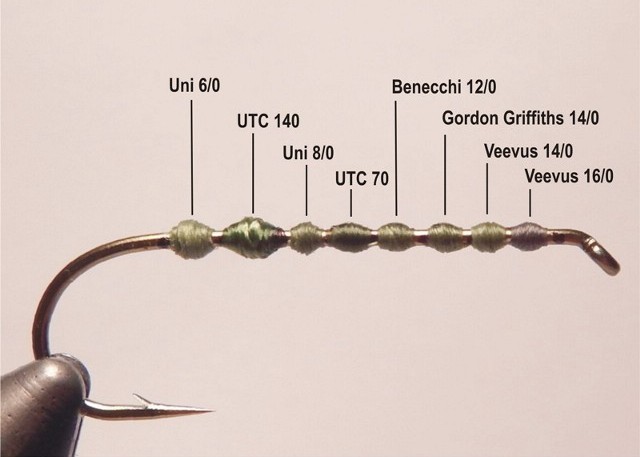I have been attending a fly tying group the past few weeks. I have learned there is a difference in thread thickness and reasons for such. However, some spools use 8/0, 6/0 and the such or 140, 160 and the such or SM, MED, and the such, and some don't say squat - aggravating... is there a chart that shows a comparison standard? How do I know???
The things you need to know about thread are:
1. Material have different properties so you need to know what the thread is made of; for example, nylon, polyester, gel spun polyester (GSP), silk, kevlar, etc
2. Thickness - These are the 6/0 designations and the numbers like 140. Supposedly the "aught" system like a 6/0 rating designates diameter BUT there is no "aught" standard so the same designation of 6/0 can be different diameter thread depending on manufacturer. Then there is denier which is a measurement of the actual mass of the thread, so it is a replacement for the "aught" system and is supposed to be a apples to apples comparison of thread.
3. Composition - How the tread is actually made. For example, is the thread twisted or not twisted. If it is twisted, is it bonded so it can it be untwisted to lay "flat" on the hook or can it be "split" to insert dubbing.
4. Waxed or not waxed. Some threads have wax to help the dubbing stick onto the thread. Other threads are unwaxed.
5. Special threads like Unistretch that have elastic properties.
These things determine the properties and performance of the thread. For example, nylon stretches and this gives the tyer more feel and the amount of stretch can help the tyer determine when the thread is about to break. Nylon is easier to dye into brighter colors. GSP is the other main material and GSP is stronger than nylon and does not stretch. It also does not dye as easily. Nylon and polyester are the most common materials for thread. Silk is mainly used for special flies and to stay true to old patterns. It is a very weak material compared to the synthetics but it takes dye better than nylon or polyester so the colors and translusence are wonderful.
With all that to consider, even with denier and the aught system, the actual bulk on the hook is not consistent comparing either the aught or deniers of threads. See the hook wrapped with 40 wraps of thread and not that threads that should be less bulky are not and threads that have equal aught numbers and denier have thicker wraps. Note the breaking strengths in the chart below for the same material and denier vary.
The best thing is to tie until you like a specific manufacturer's thread and keep using it. Having said that, a relatively new manufacturer, Veevus has become popular.
Here are a article for you to read:
Fly Tying Thread Blues | Global FlyFisher | The old aught system for tying threads (6/0, 8/0, 10/0) isn't really good. So the newer Denier system is much better, right? No, not really!
Thread table:
Fly Tying Thread Table | Global FlyFisher | A large sortable table comparing more than 90 fly-tying threads.
Here are some more "thread" threads from NAFF:
Need a stronger thread.
Veevus?
How important is the "right" hook and thread


